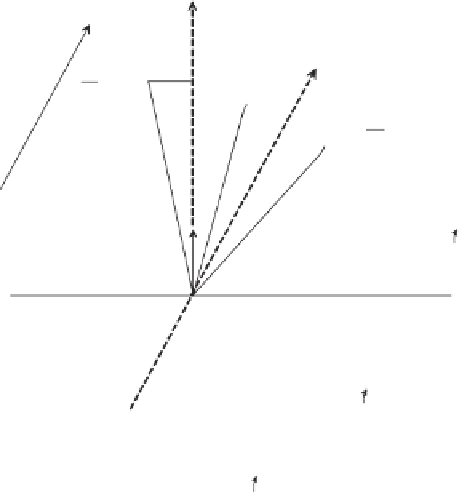Environmental Engineering Reference
In-Depth Information
problems as long as the soil is isotropic. Heterogeneity with
respect to the coefficient of permeability results in varying
distances between either flow lines or equipotential lines;
however, the respective lines must cross at 90
◦
.
The pore-water pressure distribution in the unsaturated
zone can be analyzed by considering a horizontal datum
through an arbitrary point (e.g., point
A
in Fig. 8.49) on
the phreatic line. The pore-water pressure distribution in a
direction perpendicular to the phreatic line (i.e., in the
a
-
direction) is first examined. The results are then used to ana-
lyze the pore-water pressure distribution in the
y
-direction
(i.e., vertically). The gravitational head distribution in the
a
-direction is zero at point
A(
i.e., datum) and increases lin-
early to a gravitational head of
H
cos
2
α
at ground surface.
The pore-water pressure head at a point in the
a
-direction
must be negative and equal in magnitude to its gravitational
head because the hydraulic heads are zero in the
a
-direction.
Therefore, the pore-water pressure head distribution in the
a
-direction must start at zero at the datum (i.e., point
A
) and
decrease linearly to
negative pore-water pressure head at a point on a vertical
plane can therefore be expressed as follows:
y
cos
2
α
h
pi
=−
(8.49)
where:
h
pi
=
negative pore-water pressure head on a vertical
plane (i.e., the
y
-direction) for an infinite slope,
y
=
vertical distance from the point under consideration
to the datum (i.e., point
A
), and
α
=
inclination angle of the slope and the phreatic line.
When the ground surface and the phreatic line are hori-
zontal (i.e.,
α
=
0 or cos
α
=
1), the negative pore-water
pressure head at a point along a vertical plane,
h
ps
, is equal
to
y
. This is the condition of static equilibrium above
and below a horizontal water table. The ratio between the
pore-water pressure heads on a vertical plane through an
infinite slope (i.e.,
h
pi
=−
−
y
cos
2
α
) and the pore-water pres-
sure heads associated with a horizontal ground surface (i.e.,
h
ps
=−
H
cos
2
α
at ground surface. A pore-
−
H
cos
2
α
applies to any point along
the ground surface since every line parallel to the phreatic
line is also an isobar.
The pore-water pressure head distribution in a vertical
direction also commences with a zero value at point
A
and
decreases linearly to a head of
water pressure head of
−
y
) is plotted in Fig. 8.50. The ratio of pressure heads
indicates the reduction in the pore-water pressures on a ver-
tical plane as the slope
α
becomes steeper.
The gravitational head at a point along a vertical plane
is equal to its elevation from the datum,
y(
Fig. 8.49). The
hydraulic head is computed as the sum of the gravitational
and pore-water pressure heads:
h
wi
=
1
H
cos
2
α
at ground sur-
face. However, the pore-water pressure head is distributed
along a length
H
cos
α
in the
a
-direction, while the head is
distributed along a length
H
in the vertical direction. The
−
cos
2
α
y
−
(8.50)
y
-
H
cos
2
α
a
Hydraulic head is equal to
zero along the a-direction
Pressure
head
H
Pressure
head
H
cos
2
α
y
α
α
Gravitational
head
Datum
A
Saturated zone
α
α
Figure 8.49
Pore-water pressure distribution above phreatic line in unsaturated zone during
steady-state seepage through infinite slope.
















Search WWH ::

Custom Search